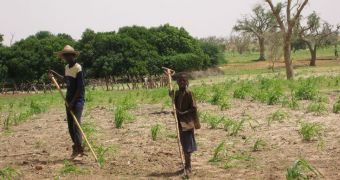For the past two decades or so, the eastern parts of the African continent have experienced numerous droughts, that succeeded one another faster and faster. According to a new scientific report, the trend is about to hold true for the foreseeable future as well.
Investigators say that global warming and temperature rise are directly linked to this phenomenon, which was forecast by climate experts to whoever would listen for many years.
Some of the most common effects of climate change, they said, will be an increased frequency of floods and droughts, whereas general precipitation patterns will shift over areas around the world.
Given this connection, it stands to reason that the effects will continue to manifest themselves with increased intensity as soon as the cause is there. And the world is not about to stop using dirty energy sources anytime soon, according to the latest reports.
Therefore, a local solution must be found to this issue, say experts from the US Geological Survey (USGS) and the University of California in Santa Barbara (UCSB), who led the new investigation.
They write that an estimated 17.5 million people face potential food shortages in the Greater Horn of Africa on account of the shift caused in these natural phenomena by human influences.
In the study paper, which appears in the latest issue of the esteemed scientific journal Climate Dynamics, the experts add that the people in this area were already at risk of being exposed to famine.
Apparently, eastern Africa gets decreasing amounts of rainfall because the Indian Ocean is getting warmer on account of human-induced climate change. The conclusions of the new study contradict a report by the Intergovernmental Panel on Climate Change.
The IPCC document featured a scenario in which eastern Africa got increased rainfall, but this is not at all what the data are showing, investigators from the two American groups are saying.
“Global temperatures are predicted to continue increasing, and we anticipate that average precipitation totals in Kenya and Ethiopia will continue decreasing or remain below the historical average,” explains Chris Funk, a scientist at USGS.
“The decreased rainfall in eastern Africa is most pronounced in the March to June season, when substantial rainfall usually occurs,” the expert goes on to say.
“Although drought is one reason for food shortages, it is exacerbated by stagnating agricultural development and continued population growth,” he adds.
“Forecasting precipitation variability from year to year is very difficult, and research on the links between global change and precipitation in specific regions is ongoing so that more accurate projections of future precipitation can be developed,” says UCSB scientist Park Williams.
“It is also important to note that while sea-surface temperatures are expected to continue to increase in the Indian Ocean and cause an average decrease in rainfall in eastern Africa, there will still occasionally be very wet years because there are many factors that influence precipitation,” he adds.

 14 DAY TRIAL //
14 DAY TRIAL //